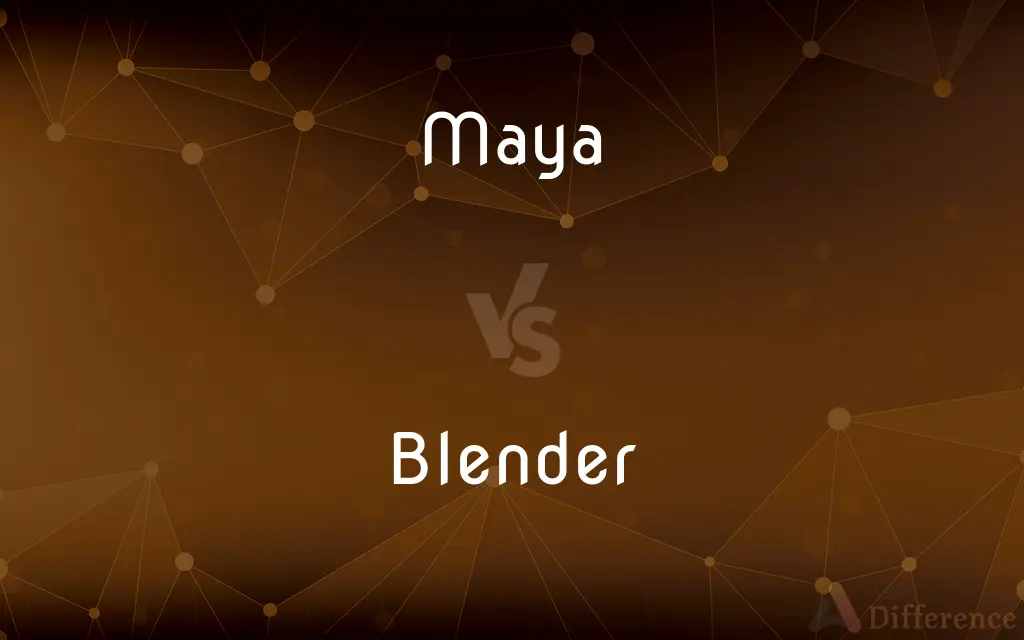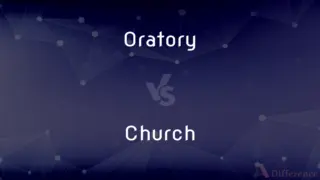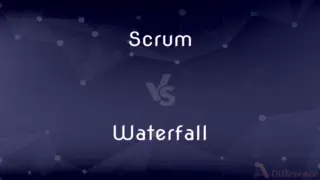Maya vs. Blender — What's the Difference?
By Tayyaba Rehman & Fiza Rafique — Updated on May 14, 2024
Maya excels in detailed animation and VFX used by professionals, while Blender is versatile and open-source, popular for 3D modeling and indie projects.

Difference Between Maya and Blender
Table of Contents
ADVERTISEMENT
Key Differences
Maya is a professional-grade software tool widely used in the film and video game industry for animation, modeling, and visual effects, often favored for its advanced rigging and animation tools. Blender, on the other hand, is an open-source 3D software that offers a broad set of features including 3D modeling, animation, and rendering, making it accessible for both beginners and professionals.
While Maya offers a complex node-based system for detailed simulations and effects, Blender integrates a user-friendly interface with a node system that caters to beginners and smaller studios. This accessibility helps users to easily learn and apply complex effects without the steep learning curve of Maya.
Maya is known for its superior ability to handle complex animation projects such as character animations and detailed environmental simulations. Blender, whereas, while capable in these areas, is more renowned for its versatility and adaptability in various aspects of 3D production beyond just animation.
In terms of rendering, Maya uses the powerful Arnold renderer, which is well-suited for handling challenging lighting and rendering tasks. Blender, on the other hand, uses the Cycles renderer which provides impressive speed and real-time rendering capabilities, appealing to users requiring quick turnaround times.
For user support and development, Maya, being a proprietary software by Autodesk, offers structured professional support and regular updates. Blender, on the other hand, relies on a global community for support and updates, which promotes rapid development but can vary in reliability.
ADVERTISEMENT
Comparison Chart
License
Commercial, paid
Open-source, free
Primary Use
Advanced animation, VFX, detailed modeling
3D modeling, animation, rendering
Learning Curve
Steep, professional-oriented
Moderate, community-driven tutorials
Rendering Engine
Arnold
Cycles
Community
Professional, industry-specific
Broad, diverse, includes hobbyists and pros
Compare with Definitions
Maya
Offers extensive rigging tools for character animation.
Animators use Maya to create detailed skeletal structures for 3D characters.
Blender
Free, open-source software for 3D modeling, animation, and rendering.
Blender is favored by indie developers for its no-cost feature set.
Maya
Used in professional studios for video games and film productions.
Maya’s advanced tools streamline the creation of complex animations.
Blender
Uses the Cycles rendering engine, known for its speed and versatility.
Blender’s Cycles enables artists to see real-time rendering changes.
Maya
High-end 3D computer graphics software for creating detailed animations and effects.
Maya is used to animate realistic creatures in blockbuster movies.
Blender
Features a user-friendly interface suitable for beginners and professionals alike.
Blender’s interface makes 3D modeling accessible to new users.
Maya
Features a powerful rendering tool, Arnold, known for high-quality output.
Maya's Arnold renderer delivers photorealistic scenes for visual effects.
Blender
Includes a built-in game engine and VR rendering support.
Blender’s game engine allows developers to create interactive 3D applications.
Maya
Supported by Autodesk, providing professional support and updates.
Regular updates in Maya introduce new features enhancing user efficiency.
Blender
A blender (sometimes called a mixer or liquidiser in British English) is a kitchen and laboratory appliance used to mix, crush, purée or emulsify food and other substances. A stationary blender consists of a blender container with a rotating metal blade at the bottom, powered by an electric motor that is in the base.
Maya
A member of a Mesoamerican Indian people inhabiting southeast Mexico, Guatemala, and Belize, whose civilization reached its height around AD 300-900. The Maya are noted for their architecture and city planning, their mathematics and calendar, and their hieroglyphic writing system.
Blender
A person or thing that mixes things together, in particular an electric mixing machine used in food preparation for liquidizing, chopping, or pureeing.
Maya
A modern-day descendant of this people.
Blender
One that blends, especially an electrical appliance with whirling blades for chopping, mixing, or liquefying foods.
Maya
Any of the Mayan languages, especially Quiché and Yucatec.
Blender
A machine with sharp rotating blades in a bowl, for mashing, crushing, or liquefying food ingredients.
Immersion blender
Maya
In Hinduism, Buddhism, and certain other East Asian religions, the transitory, manifold appearance of the sensible world, which obscures the undifferentiated spiritual reality from which it originates; the illusory appearance of the sensible world.
Blender
(theatre) A piece of fabric sewn into the front of a theatrical wig to make it blend in with the performer's natural hair.
Maya
(Hinduism) The power of a god or demon to transform a concept into an element of the sensible world.
Blender
(quilting) A subtly patterned fabric printed in different shades of a single color, often used in place of a solid to create visual texture.
Maya
Magic; supernatural power as held by the gods.
Blender
One who, or that which, blends; an instrument, as a brush, used in blending.
Maya
The power by which the universe is made to appear; the illusion of the phenomenal world, as opposed to its true or spiritual reality.
Blender
An electrically powered mixer with whirling blades that mix or chop or liquefy foods
Maya
The name (in Vedantic philosphy) for the doctrine of the unreality of matter, called, in English, idealism; hence, nothingness; vanity; illusion.
Blender
Supported by a global community that contributes to its development.
Blender’s new features often stem from community input and collaborations.
Maya
The Hindu goddess personifying the power that creates phenomena.
Maya
The power to produce illusions.
Maya
The Indian people occupying the area of Veracruz, Chiapas, Tabasco, Campeche, and Yucatan, together with a part of Guatemala and a part of Salvador. The Maya peoples are dark, short, and brachycephalic, and at the time of the discovery had attained a higher grade of culture than any other American people. They cultivated a variety of crops, were expert in the manufacture and dyeing of cotton fabrics, used cacao as a medium of exchange, and were workers of gold, silver, and copper. Their architecture comprised elaborately carved temples and palaces, and they possessed a superior calendar, and a developed system of hieroglyphic writing, with records said to go back to about 700 a. d.
Maya
The language of the Mayas.
Maya
A member of an American Indian people of Yucatan and Belize and Guatemala who had a culture (which reached its peak between AD 300 and 900) characterized by outstanding architecture and pottery and astronomy;
Mayans had a system of writing and an accurate calendar
Maya
An ethnic minority speaking Mayan languages and living in Yucatan and adjacent areas
Maya
A family of American Indian languages spoken by Mayan peoples
Common Curiosities
How does the cost of Maya compare to Blender?
Maya is a paid software requiring a subscription, whereas Blender is completely free and open-source.
Is Blender good for professional work?
Yes, Blender is suitable for professional work, especially in 3D modeling, animation, and rendering, with increasing acceptance in the industry.
What kind of support can users expect from Maya?
Maya users can access professional, structured support and regular updates from Autodesk.
Can Blender handle complex animations like Maya?
Blender can handle complex animations, but Maya is often preferred for very detailed and high-budget productions.
What is Maya primarily used for?
Maya is primarily used for high-end animation, complex simulations, and professional VFX.
What are the system requirements for running Blender?
Blender has relatively low system requirements compared to Maya, making it accessible on most modern computers.
Does Blender have features comparable to Maya?
Blender offers a comprehensive suite of features that can be comparable to Maya, though Maya typically has more advanced professional tools.
Which software is better for beginners?
Blender is generally considered better for beginners due to its intuitive interface and free access.
Can Maya and Blender be used together in a workflow?
Yes, many professionals use Maya and Blender together to leverage the strengths of both platforms in different stages of production.
Which software offers better rendering capabilities?
This depends on the specific needs; Arnold in Maya is excellent for high-quality renders, while Blender’s Cycles is fast and offers real-time rendering.
How steep is the learning curve for Maya?
Maya has a steep learning curve due to its professional-grade tools and complexity.
How does Blender support VR and game development?
Blender supports VR through rendering and has integrated tools for game development.
What is the best feature of Maya that Blender lacks?
Maya’s advanced rigging and animation tools are generally considered more sophisticated than those available in Blender.
What type of user community does Blender have?
Blender’s community is diverse, ranging from hobbyists to professionals across various industries.
What industries primarily use Maya?
The film, video game, and animation industries predominantly use Maya.
Share Your Discovery

Previous Comparison
Oratory vs. Church
Next Comparison
Scrum vs. WaterfallAuthor Spotlight
Written by
Tayyaba RehmanTayyaba Rehman is a distinguished writer, currently serving as a primary contributor to askdifference.com. As a researcher in semantics and etymology, Tayyaba's passion for the complexity of languages and their distinctions has found a perfect home on the platform. Tayyaba delves into the intricacies of language, distinguishing between commonly confused words and phrases, thereby providing clarity for readers worldwide.
Co-written by
Fiza RafiqueFiza Rafique is a skilled content writer at AskDifference.com, where she meticulously refines and enhances written pieces. Drawing from her vast editorial expertise, Fiza ensures clarity, accuracy, and precision in every article. Passionate about language, she continually seeks to elevate the quality of content for readers worldwide.













































